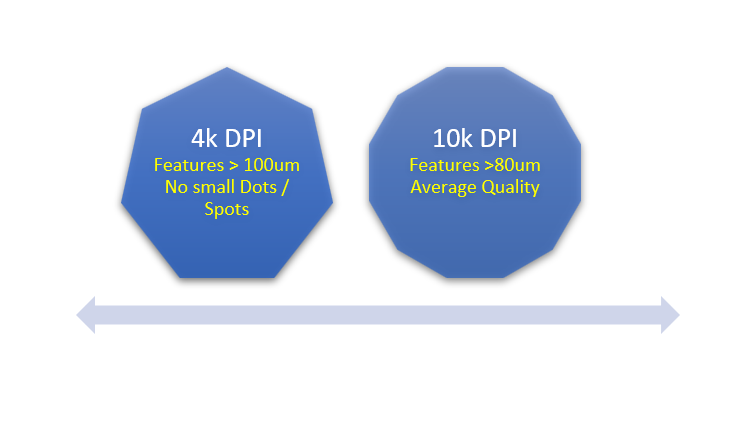Low Resolution Film Photoplotting
The following information refers to emulsion coated polyester films, imaged on our standard photoplotter upto a maximum of 812mm in size.

CHOOSING RESOLUTIONS
We can write masks at 4 different resolutions, called "DPI". The higher the resolution, the better the quality.
4k dpi : LOW Resolution. These films are suitable for general low-resolution printing applications, such as screen print and tab printing. They can also be used for photoetching/photofabrication films and low-resolution PCB-type applications. Although this resolution may resolve smaller features, we recommend keeping feature sizes above 0.2mm as corner rounding is considerable. Edge sharpness and definition are acceptable for non-critical design types, although designs with arcs/circles and lines running off a 90-degree grid may show pixilation. NO features such as lines/circles/spots/squares below 0.1mm unless on a 'best effort' basis previously agreed with our technicians.
10k dpi : LOW Resolution. This resolution will usually resolve down to 0.1 mm lines with improved line edge qualities with only a slight pixelation along edges. Corner rounding is still noticeable under magnification. NO features such as lines/circles/spots/squares below 0.08mm unless on a 'best effort' basis previously agreed with our technicians.
FEATURE TOLERANCES
There are two different values that we specify for tolerances. The first is a ‘feature tolerance’, which equates to one specific feature (also known as CD or Critical Dimension). So, if part of your mask design has a 12um channel and this is a critical feature, you can use the table below to work out possible deviations to the channel width, depending upon which resolution you choose. As a rule, the higher the resolution, then the more accurate the individual feature size will be.
All figures above in Microns....
DIMENSIONAL TOLERANCES
The second tolerance that customers ask us about is that of overall dimensional tolerances. These refer to the tolerances over a distance greater then 5mm – in layman’s terms, people ask us ‘how accurate will the mask be’ and these guidelines should go somewhere towards providing the tolerances in overall dimensions, depending upon the resolution chosen. Again, it goes without saying that the higher the resolution, then the more accurate the final mask.
Our photo-mask films are produced in conditions of 21deg C / 50% humidity, and if dimensional accuracy is a concern when using the polyester mask, then you must replicate these conditions in your own clean rooms and acclimatise the mask in these conditions for upto 8 hours before you intend to use it – only then can it be considered to be dimensionally accurate and stable. We strongly recommend using glass-based substrates where dimensional stability is a concern.
NOTE:
When using films in your own production environment, be aware that ..
1 Deg C temperature change = 18 ppm (1.8um per metre length)
1% Humidity change = 9ppm (0.9um per metre)
NOTE: where L is measuring length in MM
All figures above in Microns....
Example, a 100mm line would have a tolerance of (20.0 + 1) = +/- 20.1um




